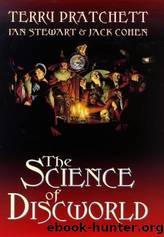Science of Discworld by Pratchett Terry

Author:Pratchett, Terry [Pratchett, Terry]
Language: eng
Format: epub, mobi
Tags: Non Fiction
Publisher: EBURY PRESS
Published: 1992-01-01T05:00:00+00:00
Bacteria belong to the grade of organisms known as prokaryotes. They are often said to be 'single-celled', but many single-celled creatures are far more complex and very different from bacteria. Bacteria are not true cells, but something simpler; they have no cell wall and no nucleus. True cells, and creatures both single-celled and many-celled, came later, and are called eukaryotes. They probably arose when several different prokaryotes joined forces to their mutual benefit — a trick known as symbiosis. The first fossil eukaryotes are singe-celled, like amoebas, and appear about 2 billion years ago. The first fossils of many-celled creatures are algae from 1 billion years ago ... maybe even as old as 1.8 billion years.
This was the story as scientists understood it up until 1998: animals like arthropods and other complex beasts came into being a mere 600 million years ago, and that until about 540 million years ago the only creatures were very strange indeed — quite unlike most of what's around today.
These creatures are known as Ediacarans, after a place in Australia where the first fossils were found.* They could grow to half a metre or more, but as far as can be told from the fossil record, seem not to have had any internal organs or external orifices like a mouth or an anus (they may have survived by digesting symbiotic bacteria in their selves, or by some other process we can only guess at). Some were flattened, and clustered together in quilts. We have no idea whether the Ediacarans were our distant ancestors, or whether they were a dead end, a lifestyle doomed to failure. No matter: they were around then, and as far as anyone knew, not much else was. There are hints of fossil wormcasts, though, and some very recent fossils look like ... but we're getting ahead of the story. The point is that nearly all Ediacaran life was apparently unrelated to what came later.
About 540 million years ago the Pre-Cambrian Ediacarans were succeeded by the creatures of the Cambrian era. For the first ten million years, these beasties were also pretty weird, leaving behind fragments of spines and spikes which presumably are the remains of prototype skeletons that hadn't yet joined up. At that point, nature suddenly learned how to do joined-up skeletons, and much else: this was the time known as the Cambrian Explosion. Twenty million years later virtually every body-plan found in modern animals was already in existence: everything afterwards was mere tinkering.
The real innovation of the Cambrian Explosion, though, was less obvious than joined-up skeletons or tusks or shells or limbs. It was a new kind of body plan. Diploblasts were overtaken by triploblasts ...
Sorry, Archchancellor. We mean that creatures began to put another layer between themselves and the universe. Ediacarans and modern jellyfish are diploblasts — two-layered creatures. They have an inside and an outside, like a thick paper bag. Three-layered creatures like us and practically everything else around are called triploblasts. We have an inner, an outer, and a within.
Download
This site does not store any files on its server. We only index and link to content provided by other sites. Please contact the content providers to delete copyright contents if any and email us, we'll remove relevant links or contents immediately.
Anxious People by Fredrik Backman(2508)
The Last Thing He Told Me by Laura Dave(2163)
The Soulmate Equation by Christina Lauren(1886)
Not a Happy Family by Shari Lapena(1555)
Romancing Mr. Bridgerton (Bridgerton 04) by Julia Quinn(1500)
Slough House by Mick Herron(1385)
Life's Too Short by Abby Jimenez(1371)
The Switch by Beth O'Leary(1364)
Kiss My Cupcake by Helena Hunting(1321)
Solutions and Other Problems by Allie Brosh(1292)
Mordew by Alex Pheby(1246)
This Time Next Year by Sophie Cousens(1173)
A Rogue of One's Own by Evie Dunmore(1093)
No One Is Talking About This by Patricia Lockwood(1057)
The Mary Shelley Club by Goldy Moldavsky(1036)
Playing Nice by JP Delaney(1019)
Roadside Picnic by Arkadi & Boris Strugatsky(991)
Squeeze Me: A Novel by Carl Hiaasen(986)
Quinoterapia by Quino(976)
